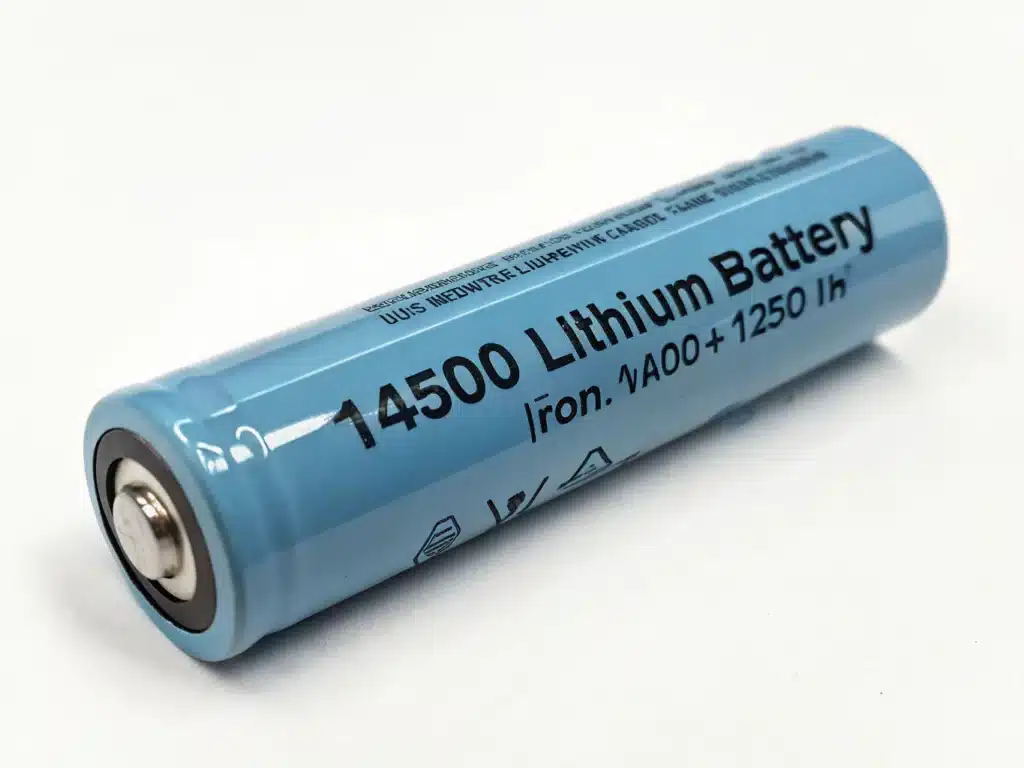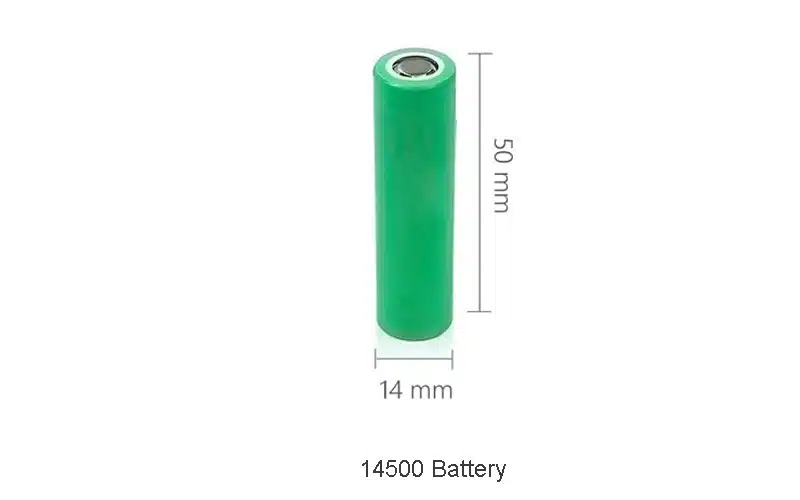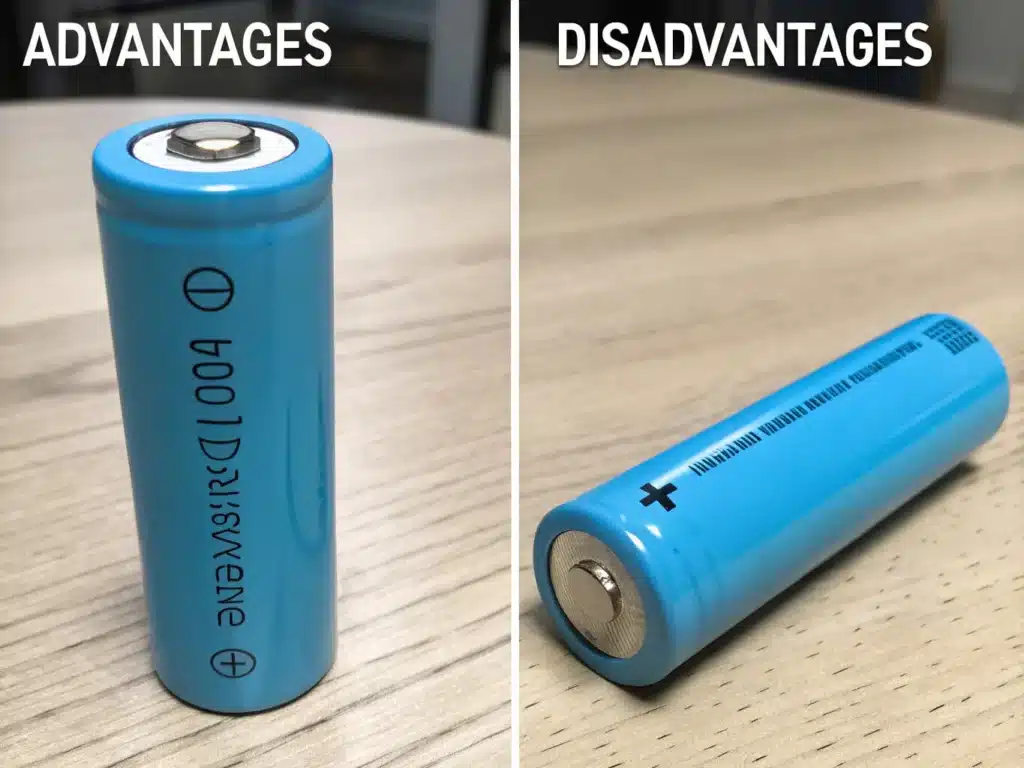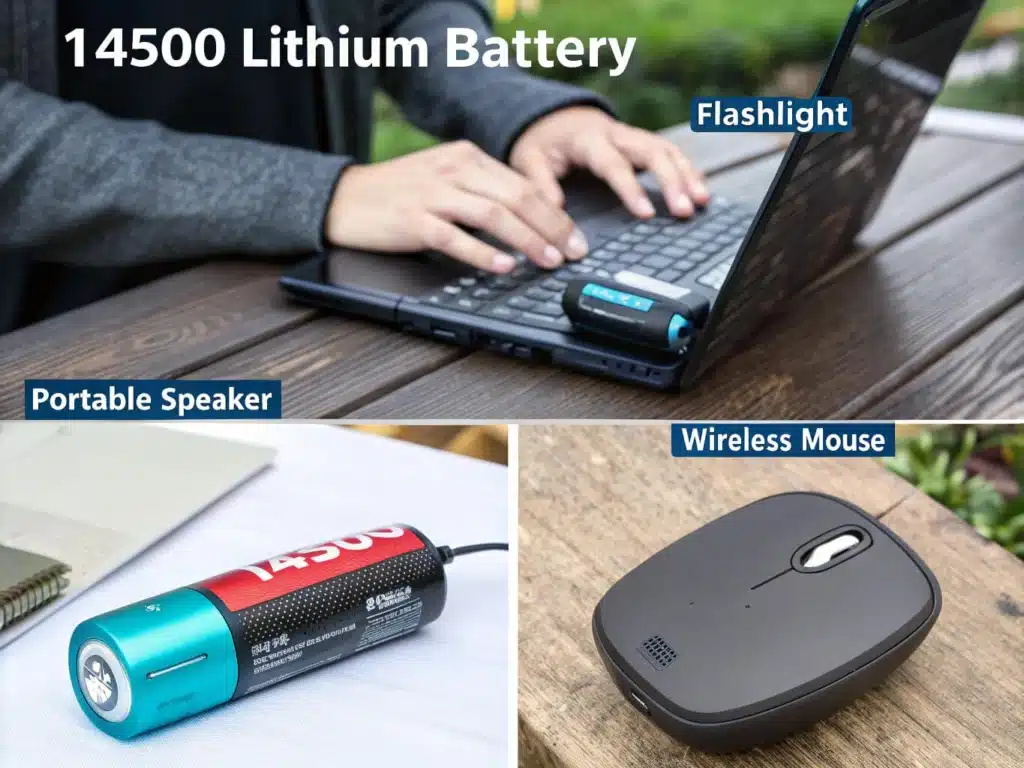The voltage of 14500 batteries (usually 3.7V) is more than twice that of ordinary AA batteries (1.2V-1.5V), even though they are the same size. This difference is not a small detail, but a decisive one that can damage your electronic devices in an instant. Although 14500 lithium batteries look the same as AA batteries, how to use them safely and correctly. This guide will tell you all the information directly, the advantages and disadvantages, application scenarios, usage and storage safety.
Table of Contents
ToggleWhat is 14500 lithium ion battery

The 14500 lithium battery is a rechargeable battery. Its name “14500” is due to its physical size specifications: the diameter is about 14 millimeters (mm) and the length is about 50 millimeters (mm). It generally uses the lithium-ion (Lithium-Ion) chemical system, and its nominal voltage is generally around 3.6V to 3.7V. The voltage can reach 4.2V when fully charged. Its size is almost exactly the same as the AA (No. 5) battery we use in our daily lives. You cannot put a 3.7V 14500 lithium battery into a device designed only for 1.5V or 1.2V AA batteries, which will cause damage to the electronic product circuit.
What is the difference between 14500 lithium rechargeable battery and AA battery?
Although the 14500 battery is similar to the common AA size, there are fundamental differences between them. Despite the similarity in appearance, the two are completely different in core electrical characteristics, chemical composition and safety requirements, and should never be confused or used interchangeably.
The biggest difference is the voltage: the standard 14500 lithium-ion battery has a nominal voltage of 3.6V or 3.7V (3.2V for lithium iron phosphate type), while the nominal voltage of AA batteries (such as alkaline, NiMH) is only 1.5V or 1.2V. This means that the voltage of 14500 batteries is two to three times that of AA batteries. If 14500 batteries directly replace AA batteries, they will inevitably burn out the main circuit of the device in an instant, causing permanent damage.
In addition, the two are completely different in terms of chemical systems, safety mechanisms, and charging requirements. Therefore, before considering using 14500 batteries, you must strictly confirm whether the device is compatible with this battery.
Specifications of 14500 3.7 v lithium battery

Physical dimensions
The diameter is about 14mm and the length is about 50mm.
The actual length of a 14500 battery with an integrated protection circuit board (Protected) usually exceeds the 50mm of the battery cell and may reach 50.5mm to 52mm.
Chemical system and nominal voltage
There are two main chemical systems for 14500 batteries:
Lithium-ion (Li-ion): Nominal voltage is typically 3.6V or 3.7V.
Lithium Iron Phosphate (LiFePO4): Nominal voltage is 3.2V.
Capacity
For a 3.7V Li-ion battery, the capacity ranges from 600mAh to 1000mAh.
For the 3.2V LiFePO4 type, the capacity ranges from 400mAh to 700mAh.
Operating voltage range
Taking 14500 lithium-ion batteries as an example, the charging cut-off voltage is about 4.2V, and the discharging cut-off voltage is generally between 2.5V and 2.75V.
Discharge performance
The maximum discharge rate of a 14500 battery can reach 5.0C. If the battery capacity is 1000mAh, then its maximum discharge current can reach 5A.
Protection Circuit
The protected battery has a built-in management chip that can provide overcharge, over-discharge, over-current and short-circuit protection, significantly improving the safety of use. This is also the method we recommend.
Batteries without protection circuits are cheaper, but lack built-in safety mechanisms and have a higher risk of improper use. They are usually used in devices with external protection measures.
Correct charger
14500 lithium batteries must be used with a dedicated charger designed for their chemistry (Li-ion or LiFePO4) and voltage. Other types of battery chargers, such as NiMH, are strictly prohibited.
Advantages and disadvantages of 14500 lithium battery
14500 lithium batteries, with their unique chemical properties, bring significant advantages, but also come with important usage limitations and risks.

Pros
- High voltage platform: This is the main advantage of 14500 lithium battery. Its nominal voltage of 3.7V (Li-ion) or 3.2V (LiFePO4) far exceeds the 1.2V/1.5V of AA battery. A single cell can provide higher power, which is suitable for compact devices that require high voltage, such as high-brightness LED flashlights.
- Higher energy density: Li-ion 14500 batteries can typically store more energy in the same volume, providing longer battery life for specially designed devices.
- Rechargeable: Can be recharged hundreds of times (LiFePO4 even thousands of times), significantly reducing long-term use costs and being more environmentally friendly than disposable batteries.
- Good power density: It can support larger continuous and peak discharge currents and meet the needs of short-term high power output of equipment.
- Unique advantages of the LiFePO4 system: The lithium iron phosphate version of the 14500 battery is popular for its higher safety (not prone to thermal runaway), 3000+ cycle life and good temperature adaptability.
Cons
- Voltage is not compatible with AA devices: Its 3.2V/3.7V voltage is 2-3 times that of AA batteries. It is absolutely forbidden to put it into ordinary electrical appliances designed only for 1.5V/1.2V AA batteries, otherwise the equipment will be burned instantly.
- Safety risks and management requirements: Lithium-ion batteries (especially unprotected or low-quality products) have the risk of thermal runaway and fire under overcharge, over-discharge, short circuit, physical damage or high temperature. We strongly recommend using batteries with protective circuit boards (PCM).
- A dedicated charger is required: You must use a dedicated lithium battery charger that matches its chemical system and voltage (such as 4.2V for Li-ion, 3.65V for LiFePO4). It is strictly forbidden to use incompatible devices such as AA NiMH chargers, otherwise it is extremely dangerous.
- Serious capacity mislabeling: The market is flooded with a large number of mislabeled products whose capacity far exceeds the actual capacity. You must be careful when purchasing and choose reputable brands, such as Hongyitai. We are a lithium battery factory in China with more than 10 years of production experience.
- Higher cost: The initial cost of the battery itself and the dedicated charger is usually higher than that of AA alkaline or NiMH batteries.
- Relatively difficult to purchase: Unlike AA batteries, which are widely available, they need to be purchased from lithium battery factories.
14500 lithium battery applications
14500 lithium batteries are mainly used in devices with specific needs rather than as a general replacement for AA batteries.

High-performance LED flashlights: This is one of the most common applications for 14500 batteries. Many compact, high-brightness flashlights are designed to use one or more 14500 batteries to use their high voltage of 3.7V or 3.2V to directly drive high-power LEDs, achieving a brighter light than AA batteries.
Specific electronic devices: A small number of devices that require higher operating voltages and have limited space will use 14500 batteries, such as medical instruments, industrial measurement equipment, and laser modules.
Small Robots: 14500 batteries are often used to power custom circuits, prototype devices, or small robots designed by DIY enthusiasts, makers, and engineers due to their energy density and voltage characteristics.
Customized battery packs: 14500 cells can be combined into battery packs through different series and parallel combinations according to specific requirements (such as voltage, capacity, and size restrictions), and equipped with precise battery management systems (BMS) for use in specific industrial equipment or portable products.
How to safely charge and use 14500 lithium batteries
Given the energy characteristics and potential risks of 14500 lithium batteries, it is critical to follow strict safety procedures, especially during charging.
Use a dedicated lithium-ion charger: You need to use a dedicated charger that can correctly identify and charge the corresponding chemical system (3.7V Li-ion or 3.2V LiFePO4). These chargers have the correct charge cut-off voltage (usually Li-ion 4.2V, LiFePO4 3.65V) and charging algorithm (usually CC/CV: constant current to constant voltage) to ensure that the battery is safely charged without overcharging.
Never use NiMH/NiCd chargers: The charging voltage and charging logic of NiMH/NiCd chargers are completely incompatible with lithium batteries. Using them to charge 14500 lithium batteries will inevitably lead to serious overcharging, which can easily cause catastrophic consequences such as battery overheating, expansion, leakage, fire, and even explosion.
Charging current: Unless the battery or charger specification clearly supports fast charging, it is generally recommended to use a lower charging current, usually 0.5C (half the battery capacity, for example, an 800mAh battery is charged with 400mA). This helps extend battery life and reduce heat during charging. Please consult the battery manufacturer’s specification.
Charging environment and monitoring: Do not leave the battery unattended during charging, especially not overnight. Keep away from flammable materials during charging. Monitor the surface temperature of the battery and charger. If abnormal overheating is found, stop charging and disconnect the power supply immediately.
Safe use and storage
Be sure to handle with care and try to avoid the battery from being hit, dropped, or pierced by sharp objects, which may cause internal damage or even cause danger. When installing the battery, make sure the positive and negative poles are in the correct direction and do not connect them in reverse. At the same time, it is strictly forbidden to put the exposed battery in your pocket or bag at will and mix it with metal objects such as keys and coins.
14500 lithium batteries should be stored in a cool, dry and well-ventilated environment, away from heat sources (such as heaters, stoves), fire sources and avoid long-term direct sunlight. For long-term storage, charge/discharge them to about 40%-60% of the power before storage, which helps slow down battery aging. To avoid short circuits, be sure to use an insulated dedicated battery box or protective cover to store the battery separately.
Choose the best 14500 battery
Choosing the right 14500 battery is not simply about capacity and price, it is directly related to whether the device can work properly, performance and safety. The following are the factors that must be considered when choosing:
Device Compatibility
Confirm that your device explicitly specifies or is compatible with 14500 lithium batteries. Voltage matching, confirm whether the device is designed for 3.7V (nominal) lithium-ion (Li-ion) batteries or 3.2V (nominal) lithium iron phosphate (LiFePO4) batteries. Physical size cannot be ignored. 14500 batteries with protection circuit boards are usually longer. Make sure the selected battery can be installed smoothly in the device.
Protection Circuit
Be sure to choose a 14500 battery with a built-in protection circuit board (PCM/BMS). A reliable protection board can provide overcharge, over-discharge, overcurrent and short circuit protection, which is the premise to prevent the risk of thermal runaway, fire or even explosion of the battery.
Chemical system
Lithium-ion (Li-ion, nominal 3.6V/3.7V): Has higher energy density, so usually has a larger capacity in the same volume (commonly 600-1000mAh). Suitable for most devices that require higher voltage and capacity.
Lithium iron phosphate (LiFePO4, nominal 3.2V): Although its energy density and capacity (commonly 400-700mAh) are slightly lower, its advantages are higher safety, more than 3,000 cycle life, and better temperature stability. It is suitable for applications with extremely high requirements for safety and life, and the equipment can adapt to its lower voltage platform.
Actual capacity and discharge capability
The 14500 market is flooded with batteries with false capacity. If you see a battery with a nominal capacity far exceeding 1000mAh (Li-ion) or 700mAh (LiFePO4), it can basically be determined to be false advertising. Do not just look at the numbers on the label, but give priority to reputable brands and refer to third-party test reports.
Understand how much discharge current your device requires. For example, flashlights, certain model power, etc. may require high-rate discharge batteries, so you need to consider 3.0C or 5.0C rates.
Battery Brand
Lithium batteries are different from ordinary dry batteries. Their quality is directly related to the safety of use and battery life. It is preferred to choose internationally renowned battery brands or factories that have been producing lithium batteries for many years.
Supporting charger
We always recommend using a quality, dedicated charger that matches the chosen battery chemistry (Li-ion 4.2V or LiFePO4 3.65V). Stay away from inferior chargers.
Conclusion
With its high energy density and voltage platform significantly higher than AA batteries, 14500 lithium batteries show their unique value in devices that require strong power or long battery life and voltage compatibility. It can provide a rechargeable solution in a volume similar to AA batteries.
FAQs
It depends on many factors! A good quality lithium-ion (Li-ion) battery can be charged and discharged about 300-500 times, while a lithium iron phosphate battery can last up to 3,000 times. The actual lifespan is also affected by usage habits (whether it is over-discharged, charging current), storage conditions (temperature, power) and the quality of the battery itself. In short, there is no fixed time, but LiFePO4 is generally more durable than Li-ion.
No. First, due to different chemical systems, lithium-ion (Li-ion) and lithium iron phosphate (LiFePO4) have essential differences in voltage platform, typical capacity, safety characteristics and cycle life. Secondly, even for the same chemical system, the actual capacity varies from manufacturer to manufacturer and batch to batch. Furthermore, the discharge capacity (C-rate) is also very different. Some batteries are designed for high-power devices that require high current output, while others are suitable for low-power applications. In addition, whether there is a protection circuit board also affects safety and discharge performance.
Not recommended. Before configuring in series or parallel, you must ensure that all cells are highly consistent in brand, model, batch, internal resistance, capacity, and age. Otherwise, any slight difference may cause individual batteries to be overcharged or over-discharged, resulting in damage or even fire and other serious safety risks.
In addition, safe battery packs often require a professional battery management system (BMS) to monitor and balance the cells to ensure overall performance and safety.
Therefore, for safety reasons, please avoid trying this on your own. If you really need a multi-cell configuration, you should choose to buy a 14500 battery pack produced by us.
